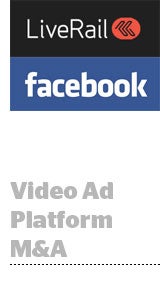 Facebook has agreed to buy video ad platform LiveRail, the companies said today. The acquisition will build Facebook’s capabilities around video, both on its own platform and on those of other publishers. LiveRail customers include Major League Baseball (MLB.com), A&E Networks, Gannett and Dailymotion, giving Facebook its first video ad server integration with premium video owners.
Facebook has agreed to buy video ad platform LiveRail, the companies said today. The acquisition will build Facebook’s capabilities around video, both on its own platform and on those of other publishers. LiveRail customers include Major League Baseball (MLB.com), A&E Networks, Gannett and Dailymotion, giving Facebook its first video ad server integration with premium video owners.
Terms of the deal weren’t disclosed, but in its talks with potential buyers, LiveRail was rumored to be asking $500 million.
Facebook’s Brian Boland, VP ads product marketing, wrote in a blog post: “We believe that LiveRail, Facebook and the premium publishers it serves have an opportunity to make video ads better and more relevant for the hundreds of millions of people who watch digital video every month. More relevant ads will be more interesting and engaging to people watching online video, and more effective for marketers too. Publishers will benefit as well because more relevant ads will help them make the most out of every opportunity they have to show an ad.”
LiveRail positions itself as a video supply-side platform (SSP). Its technology helps media companies determine the optimal yield from their video pods. Last October, the company began supporting ad breaks similar to television breaks. These could be transacted in a programmatic manner and were designed to make it easier for TV buyers to extend their broadcast campaigns more easily into digital channels.
In a 2013 interview with AdExchanger, LiveRail CEO Mark Trefgarne said, “We’re seeing more broadcast clients starting to deploy programmatic sales. As a result, more long-form content is coming into the market, along with the opportunity to have breaks with more than one ad. That also brings with it a certain amount of complexity. That’s what we’re working to address and simplify.”
LiveRail is known for having robust technology focused on video ad sellers. Speaking with AdExchanger on background, one publisher customer praised the completeness of its solution, which allows this customer to handle both video ad serving and video reach extension within a single platform — rather than working with an ad server such as FreeWheel as well as a demand-side platform like BrightRoll or TubeMogul. But he criticized the company for falling down on customer service.
“I love their technology. I think it’s very easy to use,” this customer said. “But I do see a lack in client services. I don’t know if that’s because they are growing so fast, but that’s an area for improvement.”
Buying LiveRail gives a great deal more substance to Facebook’s product plans around digital video advertising, which to date have mostly consist of user-initiated video ad formats tied to Page Posts. More recently and after much agonizing over the impact on user experience, Facebook began a test of auto-play ads in the newsfeed in a bid to capture a larger chunk of the billions in branding dollars that today flow to television.
In a research note to investors, Wells Fargo senior analyst Peter Stabler heralded this opportunity for Facebook.
“The addition of LiveRail should substantially broaden the inventory opportunity for FB sales, offering greater audience reach and an ability to sell into a broader range of video advertisers,” he wrote. “We believe that by combining its superior targeting capabilities and a vastly expanded supply of premium and long-tail video, Facebook is now even better positioned to capitalize on this shift [of branding dollars to digital].”
Additionally, the acquisition lends weight to recent chatter that Facebook is pushing hard to develop an advertising stack that could put it into direct competition with Google’s DoubleClick platform. The Facebook “ad stack” already includes the Atlas ad management platform, Facebook Exchange and Facebook Audience Network. However those solutions are all geared to the buy-side of digital advertising, whereas LiveRail represents its first major foray into sell-side ad tech solutions. The company recently hired David Jakubowski, former CEO at Aggregate Knowledge, to help drive its investments in ad technology












